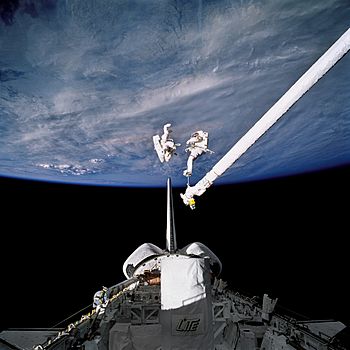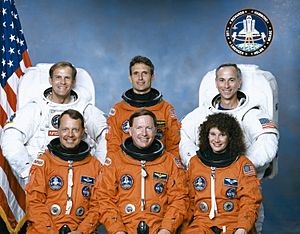STS-64 facts for kids

Lee and Meade perform an untethered EVA with SAFER backpacks above Discovery's payload bay
|
|
| Mission type | Research Technology |
|---|---|
| Operator | NASA |
| Mission duration | 10 days, 22 hours, 49 minutes, 57 seconds |
| Distance travelled | 7,242,048 kilometers (4,500,000 mi) |
| Orbits completed | 176 |
| Spacecraft properties | |
| Spacecraft | Space Shuttle Discovery |
| Payload mass | 9,260 kilograms (20,410 lb) |
| Crew | |
| Crew size | 6 |
| Members |
|
| Start of mission | |
| Launch date | 9 September 1994, 22:22:35 UTC |
| Launch site | Kennedy LC-39B |
| End of mission | |
| Landing date | 20 September 1994, 21:12:52 UTC |
| Landing site | Edwards Runway 4 |
| Orbital parameters | |
| Reference system | Geocentric |
| Regime | Low Earth |
| Perigee | 259 kilometres (161 mi) |
| Apogee | 269 kilometres (167 mi) |
| Inclination | 56.9 degrees |
| Period | 89.5 min |
  Left to right – Front: Hammond, Richards, Helms; Back: Lee, Linenger, Meade |
|
STS-64 was a Space Shuttle Discovery mission. It launched from Kennedy Space Center in Florida on September 9, 1994. The mission lasted almost 11 days. It landed safely on September 20, 1994, at Edwards Air Force Base. The main goal of STS-64 was to perform many different science experiments.
Contents
Who Were the Astronauts on STS-64?
| Position | Astronaut | |
|---|---|---|
| Commander | Richard N. Richards Fourth and last spaceflight |
|
| Pilot | L. Blaine Hammond, Jr. Second and last spaceflight |
|
| Mission Specialist 1 | Jerry M. Linenger First spaceflight |
|
| Mission Specialist 2 | Susan J. Helms Second spaceflight |
|
| Mission Specialist 3 | Carl J. Meade Third and last spaceflight |
|
| Mission Specialist 4 | Mark C. Lee Third spaceflight |
|
What Was the Spacewalk Like?
Astronauts Mark Lee and Carl Meade performed a spacewalk during the STS-64 mission. This was a special moment because it was the first time in 10 years that a U.S. astronaut had floated freely without being tied to the spacecraft.
- Spacewalk Start: September 16, 1994 – 2:42 PM UTC
- Spacewalk End: September 16, 1994 – 9:33 PM UTC
- How Long It Lasted: 6 hours and 51 minutes
What Did STS-64 Accomplish?
The STS-64 mission had many important goals. It was the first time a new technology called LITE was used in space. Astronauts also tested a special backpack for spacewalks.
Exploring Earth's Atmosphere with LITE
LITE stands for Lidar In-space Technology Experiment. Lidar is like radar, but it uses laser light instead of radio waves. It helps scientists study Earth's atmosphere. This was the first time lidar was used in space.
The LITE tool worked for 53 hours. It collected over 43 hours of detailed information. Scientists got amazing views of clouds, storms, dust, and pollution. They also studied how light reflects off Earth's surface. LITE observed areas over Europe, Indonesia, the South Pacific, Russia, and Africa.
Sixty-five groups from 20 countries helped check the LITE data. They used instruments on the ground and in airplanes. The LITE science program was part of NASA's Mission to Planet Earth. This mission helps us understand our planet better.
Testing the SAFER Backpack for Spacewalks
On September 16, astronauts Mark Lee and Carl Meade performed a spacewalk. This was the 28th spacewalk in the Space Shuttle program. During their spacewalk, they tested a new backpack called SAFER. SAFER stands for Simplified Aid for EVA Rescue.
This backpack is designed to help an astronaut if they accidentally float away from the spacecraft. It was the first time an untethered spacewalk happened since 1984. SAFER became a very important tool for spacewalks. It was used during the building of the International Space Station and in many missions after that.
Studying the Sun with SPARTAN-201
On the fifth day of the mission, the crew released a small satellite. It was called SPARTAN-201. The Shuttle's robotic arm carefully placed it into space. This was SPARTAN-201's second trip on the Shuttle.
SPARTAN-201's job was to collect information about the solar wind. It also measured parts of the Sun's outer atmosphere, called the corona. The data was stored on board and sent back to Earth later. After two days of collecting data, SPARTAN-201 was brought back to the Shuttle by the robotic arm.
Other Experiments on Board
The STS-64 mission carried several other experiments.
- SPIFEX: This was a 33-foot (10-meter) extension for the Shuttle's robotic arm. It had sensors to collect data about the Shuttle's small steering rockets. This helped scientists understand how these rockets might affect large structures in space, like the Mir space station or the planned International Space Station.
- ROMPS: The Robot Operated Processing System was the first U.S. robot system used in space. It was placed in two special containers in the cargo bay.
- GAS Bridge Assembly: This part of the cargo bay held 12 more containers. Ten of these containers had their own self-contained experiments.
Inside the Shuttle, astronauts also worked on other projects:
- BRIC: The Biological Research in Canister experiment studied how spaceflight affects plants.
- MAST: Military Application of Ship Tracks took detailed pictures of ship tracks in the ocean. This helped analyze how ship wakes form and disappear.
- SSCE: The Solid Surface Combustion Experiment studied how flames spread over materials in space.
- RME III: Radiation Monitoring Equipment III measured radiation levels in space.
- SAREX II: The Shuttle Amateur Radio Experiment II allowed astronauts to talk to amateur radio operators on Earth.
- AMOS Test: The Air Force Maui Optical Station test was done without any special equipment on the Shuttle.
STS-64 was also the first mission where astronauts wore a new type of full-pressure spacesuit. This suit was called the Advanced Crew Escape Suit. It replaced older, partial-pressure suits.
Images for kids






